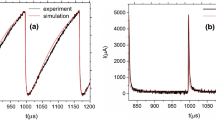Abstract
A simulation method based on separation of variables for DC discharge is developed by analyzing various physical mechanisms with exponential dependencies inherent in the governing equations. The advantages of the developed method are simplicity, which does not require processes such as matrix inversion, and that it ensures numerical stability at large time step. The present method is applied to a one-dimensional theoretical model of Ar discharge, and the results are compared with those of the previously developed dielectric relaxation scheme (DRS) that had already been compared and verified with other several methods. While the DRS method, which has similar advantages, uses current as the input variable, the current method uses voltage as the input condition, and the electric field is directly calculated under that voltage condition through Gauss’ law rather than through Poisson’s equation. Summarizing the analysis of the simulation results, the accuracy is acceptable, and the saturation speed is faster with the present method.








Similar content being viewed by others
References
J.R. Roth, Industrial Plasma Engineering, Vol. 1: Principles (IOP Publishing Ltd, Bristol, 1995), p.258
J.R. Roth, Industrial Plasma Engineering, Vol. 2: Applications to Nonthermal Plasma Processing (IOP Publishing Ltd, Bristol, 2001)
M.A. Lieberman, A.J. Lichtenberg, Principles of Plasma Discharges and Materials Processing (Wiley, New York, 2005)
Y.P. Raizer, Gas Discharge Physics (Springer, Berlin, 1991)
W.H. Press et al., Numerical Recipes in C++, vol. 19.2 (Cambridge Univ. Press, Cambridge, 2002)
W. Schmitt, W.E. Köhler, H. Ruder, J. Appl. Phys. 71, 5783 (1992)
A. Bogaerts, R. Gijbels, W.J. Goedheer, J. Appl. Phys. 78, 2233 (1995)
M. Surendra, D.B. Graves, L.S. Plano, J. Appl. Phys. 71, 5189 (1992)
M. Surendra, D.B. Graves, G.M. Jellum, Phys. Rev. A 41, 1112 (1990)
I. Rafatov, E.A. Bogdanov, A.A. Kudrayvtsev, Phys. Plasmas 19, 033502 (2012)
M.N. Stankov et al., Rom. J. Phys. 59, 328 (2014)
H.-J. Kim, D.-C. Kwon, N.S. Yoon, J. Korean Phys. Soc. 51(2), 633 (2007)
S.V. Patankar, Numerical Heat Transfer and Fluid Flow (McGraw-Hill, New York, 1980), p.52
D.L. Scharfetter, H.K. Gummel, IEEE Trans. Electron. Devices 16, 64 (1969)
D.C. Kwon, N.S. Yoon, J.H. Kim, Y.H. Shin, K.H. Chung, J. Korean Phys. Soc. 47, 163 (2005)
H.H. Choe, N.S. Yoon, S.S. Kim, D.I. Choi, J. Comput. Phys. 170, 550 (2001)
H.H. Choe, N.S. Yoon, J. Korean Phys. Soc. 42, S859 (2003)
H.Y. Kim, D.C. Kwon, N.S. Yoon, H.H. Choe, J.H. Kim, J. Korean Phys. Soc. 49, 1967 (2006)
F.C. Liu, Y.F. He, L.F. Dong, Phys. Plasmas 21, 123503 (2014)
Acknowledgements
This work was supported by a funding for the academic research program of Chungbuk National University in 2023.
Author information
Authors and Affiliations
Corresponding author
Additional information
Publisher's Note
Springer Nature remains neutral with regard to jurisdictional claims in published maps and institutional affiliations.
Rights and permissions
Springer Nature or its licensor (e.g. a society or other partner) holds exclusive rights to this article under a publishing agreement with the author(s) or other rightsholder(s); author self-archiving of the accepted manuscript version of this article is solely governed by the terms of such publishing agreement and applicable law.
About this article
Cite this article
Yoon, NS. A simulation method of DC discharge using separation of variables. J. Korean Phys. Soc. 84, 758–765 (2024). https://doi.org/10.1007/s40042-024-01052-4
Received:
Revised:
Accepted:
Published:
Issue Date:
DOI: https://doi.org/10.1007/s40042-024-01052-4




